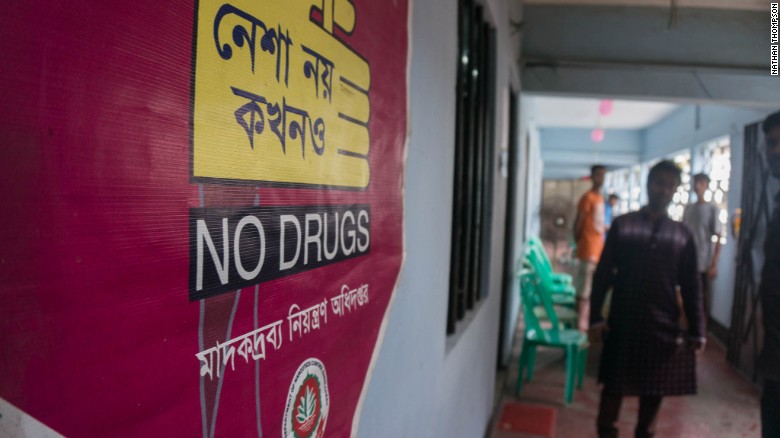Yaba addiction: The dark side of Bangladesh's increasing affluence
Dhaka, Bangladesh (CNN)"I'm telling your dad," said Angela and marched out with a fistful of foil and methamphetamine pills.
Rafi watched his bedroom door swing shut and wondered why he wasn't trying to stop her.
Rafi was only 24, but his skin was gray and each ragged eye was Martian red. His head jerked an involuntary tick; he coughed and wondered what to do next.
Sponsor Content
A new age of startups: How Tunisia’s millennial entrepreneurs are boosting the economy
The country is in the midst of a startup revolution that’s giving young people choices andchanging the face of the modern workforce
Content provided by GIIF & UNIDO
Angela had been rifling through his drawer looking for a cigarette when she found Rafi's stash of pills that he had been smoking from foil -- known among users as "chasing the dragon."
"I didn't try and stop her because I realized getting caught was good," said Rafi, while relaying the story.
"I really wanted to stop because I was feeling horrible ... My parents must have known something was wrong, but I think they were in denial," he added.
In 2006, Rafi was one of the rich kids who started using the colorful pills, known as yaba, when they first began circulating in Dhaka, the Bangladeshi capital.
Today, yaba is everywhere.
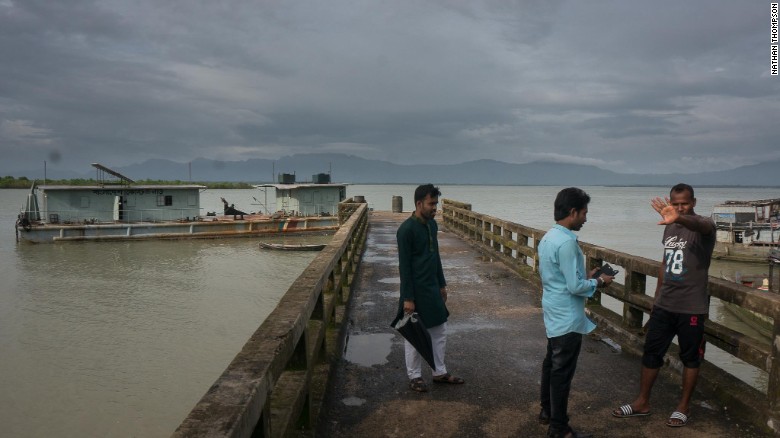
An off-duty boarder guard blocks his face from being photographed. The Naf river that divides Bangladesh and Myanmar is perforated by illegal vessels carrying drugs and Rohingya refugees. Officials here distrust journalists.
Yaba is a combination of methamphetamine and caffeine. They are candy like tablets that come in different flavors, and bright colors. Users typically heat the tablet, which sits on aluminum foil, and then inhale the vapors from the melting tablets. Others crush the tablets into powder and snort them.
The Bangladesh Border Guards are busting more and more smugglers. They seized more than 29 million pills last year, more than 35 times the amount confiscated in 2010, according to figures from the Department of Narcotic Control. In 2016, they confiscated more than 29 million pills in an array of attractive colors.
"Myanmar is perceived to be the main country of origin for methamphetamine tablets seized throughout the Mekong sub-region and to some other parts of East and South-East Asia," said a 2015 report by the United Nations Office for Drugs and Crime (UNODC). The report added that, in 2013, 90% of the taba pills seized in China had originated as meth in Myanmar.
Didarul Alam Rashed runs a drug treatment center for two dozen clients in Cox's Bazar near the border with Myanmar as part of the Non-Governmental Organization for National Goals to be Obtained and Retained (NONGOR). He has been in prime position to witness the yaba increase.
"We did an informal survey in 2002 and found 20,000 people were addicted to drugs in the district but none of them were using yaba," he said, adding that their drugs of choice back then were weed and heroin.
"In 2007 there was a flood of yaba and afterwards it was everywhere. When we repeated our survey in 2016 we found 80,000 people were addicted to drugs and about 80% were using yaba."
'Yaba is destroying our young people'
In 2013, Oishee Rahman was a 17-year-old addicted to yaba.
Her parents worried about their wayward daughter so they confiscated her phone and confined her to their Dhaka apartment. Angry, she mixed their coffee with sedatives.
Rahman watched their heads nod into sleep. Then she took a kitchen knife and stabbed them both to death.
She locked her younger brother in the bathroom and called a friend to pick her up. She later handed herself in to police, and allegedly confessed.
Rahman was sentenced to death in November 2015. In its verdict, the court said Rahman had "planned the murder well ahead." She was 19 years old at the time.
In June of this year, a Dhaka High Court commuted Rahman's death sentence to life in prison, having taken into account her age and her mental health.
Her case was a lightning rod for the anxiety Bangladeshis feel about yaba use among young people, with many commentators blaming the drug for warping Rahman's mind.
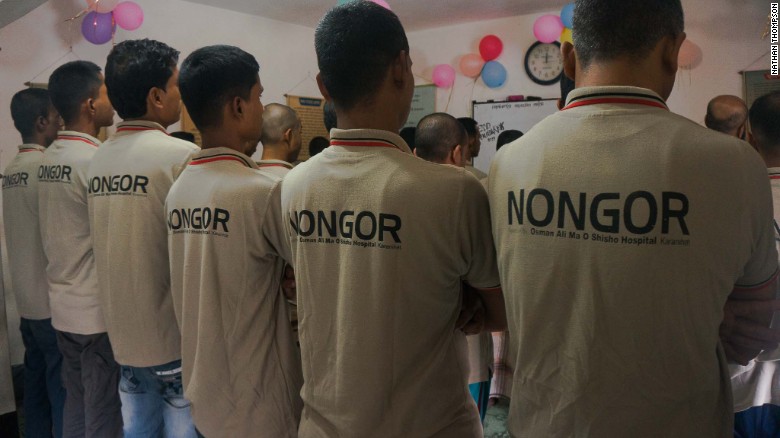
Clients at NONGOR drug treatment centre in Cox's Bazar. They want to remain anonymous as some were involved in crime and drug trafficking but, for now, they are clean and sober.
In the Department of Narcotic Control's (DNC) 2014 annual report, the most recent one available, they estimated 88% of drug users were aged below 40. A study in Sylhet city, released this year, found 55% of drug users were aged 22-29.
Yaba pills typically contain methamphetamine, caffeine and non-active bulking agents. It creates a hyper-alert state of rushing energy.
"It has a vanilla smell and the smoke tastes like I can't explain," said Rafi. "First there is a warm feeling in your chest and then you get this rush."
Rafi, who says he's been clean for several years, first started taking the drug when he was a DJ in Dhaka, it helped him stay up all night. As his addiction progressed, he cared less about socializing and preferred to just get high with his friend.
Rafi described a typical day when he was at the height of his addiction, consuming up to four powerful pills a day. "I used to wake up at 9 or 10 a.m. after forcing myself to sleep for a few hours, smoke yaba and head to work and arrive severely late."
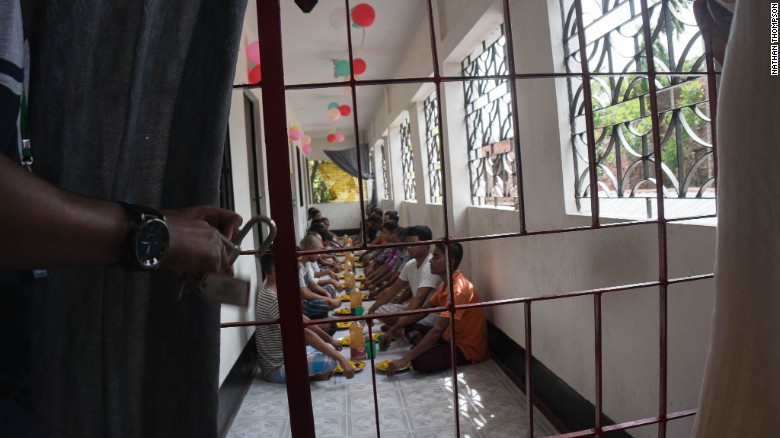
Clients at an addiction treatment centre in Bangladesh eat lunch together. They form a therapeutic community and help each other to stay clean. It's not a prison, but the doors are locked in case the craving for drugs becomes so unbearable that they try to escape.
"After work, I would call my friend and get to his house around 6 p.m.; the dealer would deliver the stuff and then we'd smoke it and play FIFA on the PlayStation -- 20 or 30 games in a row," Rafi continued. "This went on for two or three years, the same routine every damn day."
Kashem, who withheld his last name, is in treatment at NONGOR for his yaba addiction and is currently sober. The 37-year-old recounted how things have changed since he was young.
"Back in the 1990s we only had heroin or weed," he said. "Only 5-10% of the people I knew took drugs, but now half of all young people are using yaba."
"When the new drug came along everyone wanted it," he continued. "It was better than heroin because that made you feel weak, but yaba fires up the blood and make the body strong as a lion."
Kashem is now worried about his own children. He is sending his eldest son, who has just finished school, to work in Saudi Arabia where drugs are much harder to get. "I don't want him to end up like me," he said.
The Ultimate Merchandise
Drugs, as US writer William Burroughs once said, are a consumer product and so market forces are a good place to look for explanations.
In the late 1990s, the drug gangs in neighboring Myanmar began to switch from making heroin to making yaba. The synthetic yaba pill doesn't depend on unreliable opium harvests; it is small, attractive and easy to smuggle.
Manufacturers often stamp each pill with a symbol that acts like a brand. In Bangladesh "R7" is the most popular.
According to the Dhaka Tribune, a single R7 pill costs up to 900 taka ($11). A cheaper version, called "Pink Champa," goes for about 300 taka ($3.7). The strongest brand, known as "Controller," costs up to 2,000 taka ($25).

A sailor walks from a boat that crosses the Naf River daily, taking goods between Myanmar and Bangladesh. Yaba methamphetamine pills are often hidden in cases of ginger or dried fish, former user Kashem told CNN.
When the Chinese and Thai borders were tightened the gangs needed new routes to international markets and Bangladesh, with its busy sea ports and porous borders, seemed the obvious choice. Plus it was a proving a lucrative market itself.
"Given that interdiction efforts have been strengthened along the joint border between Myanmar to China and Thailand, there are indications that drug traffickers have shifted routes," the UNODC report said.
Yaba first appeared among the Bangladeshi elites, people who the rest of the population aspired to be like.
"Yaba became a symbol of smartness, fashion and aristocracy. Model girls, film heroines, singers, dancers and many of the celebrities became a subject of media reports for abusing yaba," said the DNC report.
Jeremy Douglas, regional representative of the UNODC, said that the real scale of the problem is still unknown. "Bangladesh has characteristics that make it an attractive market for organized crime to develop," he said.
"We can't estimate the yaba/meth trade in Bangladesh given such limited data (extremely limited). Based on frequent and increasingly large seizures we know traffickers are pushing product into the country, but it can't be estimated purely on that basis," Douglas added.
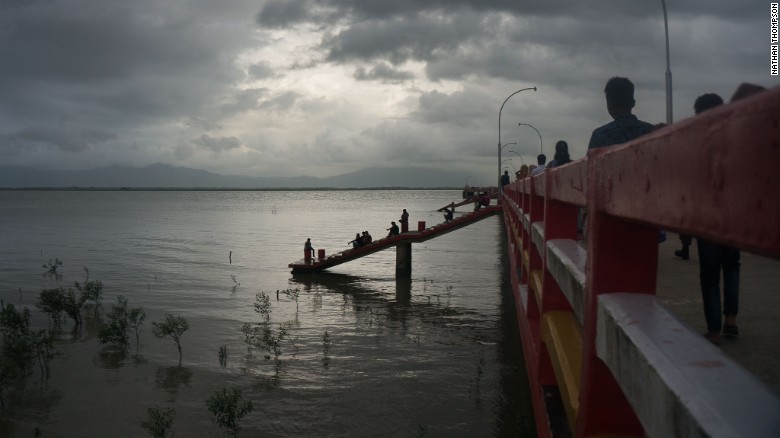
Bangladeshis take a stroll on a peer that juts out into the Naf River that divides Bangladesh and Myanmar. Every year millions of yaba methamphetamine pills are smuggled across this river feeding the nation's pill-a-day habit.
Bangladesh shares a 4,000-kilometer (2,485 mile) border with India and a 250-kilometer (155 mile) border with Myanmar's Rakhine state -- the scene of the current Rohingya refugee crisis. The monumental task of policing these areas has been made more difficult by corruption.
"Our government is serious about stopping yaba," said Najnin Sarwar Kaberi, organizing secretary for the ruling Awami League party in Cox's Bazar, a fishing town in Bangladesh.
"But it's difficult because some junior officials are involved in smuggling and some foolish border guards are taking payments and letting the drugs in. It's very hard to find out who is involved," she said.
Soman Mondal, assistant director of the narcotics control office in Cox's Bazar, disputed the allegation that border guards are corrupt. "I have never received any complaints about my staff being involved in drug distribution," he said. He added that if drugs are getting through it is because his office is grossly understaffed.
Border guards make a mere $25 a week, below the average income of $108 per month.
Kaberi favors a zero-tolerance approach to stamp out the yaba problem. "I would support the death penalty for yaba smugglers," she said. "And the government must increase the number of rehabs."
The Department of Narcotic Control currently lists only five government-run treatment centers and there are 68 private institutions according to a 2015 report by the World Health Organization.
But rehabs are not the only answer. Rafi managed to quit yaba with the only support of his family.
"My dad is a chilled guy," Rafi said. "He didn't get angry or force me to go to rehab. He wanted to talk and find out why I was doing it. It took Angela a while to trust me again, but she stood by me."
Maybe that was why he could let his habit go and become the successful businessman he is today. "I had friends who went to rehab and they all relapsed," he said. "You have to want to give up. It all comes down to that."
News Courtesy: www.cnn.com

